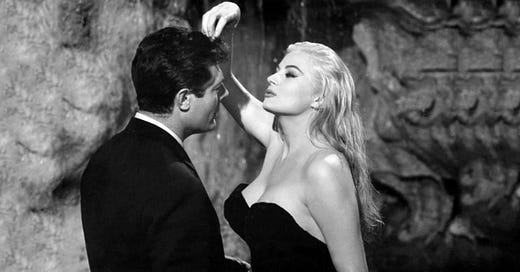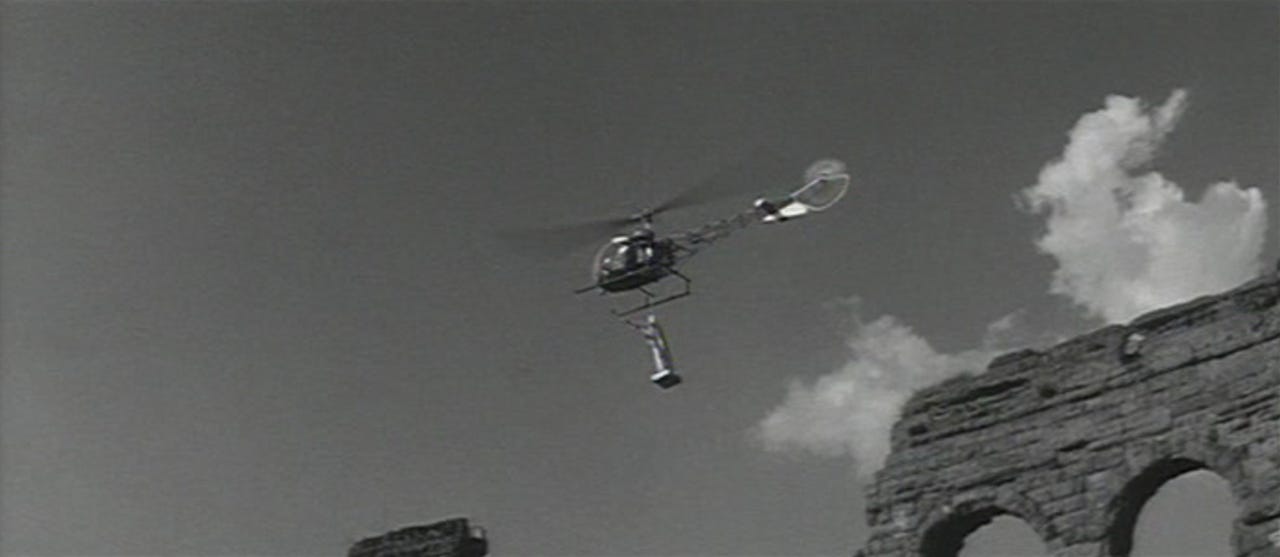The unbearable lightness of 'La Dolce Vita'
Federico Fellini's greatest film examines the seductive highs and hangover lows of celebrity culture.
When Anita Ekberg, one of the most impossible blondes in movie history, hits a Rome tarmac in Federico Fellini’s La Dolce Vita, a gaggle of tabloid photographers fall over each other to get the best picture, entranced by a beauty of Marilyn Monroe-like caliber. And Ekberg’s Sylvia giddily rewards their attention by throwing her chest out and blowing kisses, the two parties utterly compatible in boosting Sylvia’s stardom while giving readers what they want. Together, they create a pop culture moment of irresistible silliness and apparent harmlessness, light as the fizz from an uncorked champagne bottle.
Much later in Fellini’s three-hour masterpiece, this same gaggle of photographers (who we now shorthand as “paparazzi,” thanks to a character from the film) rushes toward a woman who doesn’t yet know of the shocking tragedy that unfolded in her apartment above. The woman smiles at the attention (“Did you think I was an actress?”) before getting ferried away in a police car, where she can receive the worst news of her life in semi-privacy before again becoming part of the news. The press behaves no differently than it does on the tarmac, but now the two parties are utterly incompatible, and that fizzy pop culture moment has turned into the darkest of hangovers.
La Dolce Vita is full of rhymes and dualities like that, as Fellini drinks in the seductiveness of celebrity and media culture before registering its existential costs in full. And in the center of this three-ring circus is the dashing Marcello Mastroianni, who goes by his real first name as a journalist who’s not only present for all these events, but enjoys a level of access that we might understand as enviable. He’s not one of the goofy shutterbugs devouring each other for access, but a person of influence and style, invited to all the best parties and nightclubs, and known by the most elite stars, socialites, aristocrats and intellectuals. It takes the entire film to understand how unenviable a life that turns out to be.
And who knows if the audience got the message? La Dolce Vita was a box-office sensation when it came to America a little over 60 years ago, and surely Fellini’s ability to conjure the glamor of wealth and popular culture was no small part of that success. Who wouldn’t want to tour modern Rome alongside Marcello, a man who splashes around Trevi Fountain with Anita Ekberg, has relationships with half a dozen beautiful women, and zips from The Cha Cha Club to an honest-to-goodness castle with the top down on his convertible? As much as Fellini darkens this lifestyle, with even the title curdling into a bitter irony, he doesn’t undersell the highs that Marcello is doomed to chase. His addiction is shared by many of us.
Unfolding in seven episodes, many shifting from the debauchery of nighttime to the cold light of day, La Dolce Vita opens with one of its most famous sequences, as a helicopter carrying a statue of Christ wends its way through a city of ancient façades and bikini-clad sunbathers. This isn’t the last time that Fellini will juxtapose the sacred and the profane, and it serves as the perfect introduction to Marcello, who’s perpetually drawn to the latter. Rather than keep following Jesus’ descent from the heavens, he pauses the news helicopter to get the sunbathers’ phone numbers. That he cannot actually hear what these women are saying is a recurring motif Fellini will follow to the very end.
The women of La Dolce Vita are luscious but have more depth than Marcello seems capable of acknowledging, much less satisfying. He enjoys his splash in the fountain with Sylvia, but that fantasy ends abruptly, with the actress returning to a furious fiancé eager to put them both in their place. Marcello has an ongoing affair with a wealthy but melancholy heiress, Maddalena (Anouk Aimée), but when she finally seeks commitment, they’re literally in separate rooms, with her words echoing past him. He has dalliances with a French dancer (Magali Noël), tries to arrange an orgy like an out-of-rhythm orchestra conductor, and has an encounter with an innocent young waitress (Valeria Ciangottini) the one time he sits down to do some writing. All the while, the one true woman in his life, Emma (Yvonne Fumeaux), is made to suffer from his narcissism.
As rigorously structured and intellectualized as the film is, Fellini never makes it seem like an academic exercise or some heavy-handed polemic about the fall of modern Rome. Fellini wants the audience to feel what it’s like to be Marcello — living completely in the moment, between dusk and dawn, drifting in and out of the hippest parties and most surreal events. The emptiness of his life isn’t immediately obvious in the film, in part because he comes across as a bystander to the decadent culture, rather than emblematic of it. It isn’t until a beach party in the closing minutes, when he’s gone astray and lost the younger crowd, that his patina of cool has worn off.
Fellini’s filmmaking brio gives the individual episodes of La Dolce Vita a standalone quality, even while many share a heightened reality. A sequence where Marcello visits a site where two schoolchildren have reportedly sighted the Madonna — one of several references ripped from actual headlines — morphs into the sort of empty media spectacle that would keep repeating itself for TV cameras in years to come. An evening at the Cha Cha Club where Marcello tries to impress a father he’s neglected only underlines the superficiality until Fellini pauses to appreciate the deft magic of a solo trumpeter who makes balloons float across the floor like the Pied Piper.
The influence of La Dolce Vita is everywhere now, whether referenced directly, as in Paolo Sorrentino’s movie-length homage The Great Beauty, or in pieces, like the decadent spirit of Spring Breakers or the top-down tour of late ’60s Los Angeles in Once Upon a Time in Hollywood. The story Fellini is telling about the relationship between celebrities and the press — at times mutually beneficial, inevitably destructive — has been retold countless times by all the faded stars that once burned bright. And like Marcello, we cannot remove ourselves so easily from a superficial culture that fails to nourish our souls. There’s always another high to chase.






The last time I saw this was at a repertory screening, which is probably the best way to experience it. Not just for the richness of Fellini’s images, but because the inability to pause and take a break means the viewer is left just as exhausted of “the sweet life” as Marcello is by the end.
The Trevi Fountain was a Final Jeopardy! question this week and while I couldn't remember the exact name, I could only shout "the fountain from La Dolce Vita!" Just an all timer.